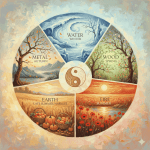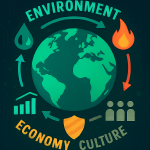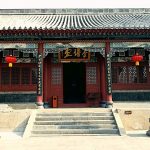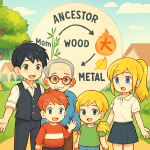Yin & Yang
The core of the Yin-Yang theory holds that everything in the universe contains two opposing yet interdependent aspects: Yin and Yang.
Opposition: Yin and Yang repel and restrict each other. For example, heaven is Yang, earth is Yin; movement is Yang, stillness is Yin; heat is Yang, cold is Yin.
Interdependence: Neither Yin nor Yang can exist in isolation. As the saying goes, “Solitary Yin cannot grow, and solitary Yang cannot thrive”—one is the precondition for the other.
Transformation: Under certain conditions, Yin and Yang can convert into each other. For instance, extreme cold generates heat, extreme heat generates cold; day (Yang) turns into night (Yin).
Waxing and Waning: The forces of Yin and Yang are not fixed but in a dynamic balance of “one wanes as the other waxes.” The alternation of cold and heat in the four seasons exemplifies this.

The Five Elements
The Five Elements Theory was established during the Zhou Dynasty and matured during the Warring States Period. It serves as the intellectual framework and philosophical foundation of the Chinese people, and has been applied to Chinese astronomy, geography, medicine, and even various industries. The Chinese people use the Five Elements Theory to explain the laws of change in all things in the world, believing that the world is composed of five elements (Wood, Fire, Earth, Metal, Water) including human body, family relations and society, these five elements transform into one another, constrain one another, and interact through a cycle of mutual generation and mutual restraint, undergoing constant change. Unlike the Western idea of static “elements,” the Chinese system emphasizes the relationship, wholistic & dynamic balance, and transformation.
- Characteristics of the Five Elements:
- Wood: Represents growth, upward movement, and flexibility (e.g., the growth of plants).
- Season: Spring
- Direction: East
- Color: Green/Blue
- Organs (TCM): Liver, Gallbladder
- Emotion: Anger
- Fire: Symbolizes warmth, upward direction, and brightness (e.g., the burning of flames).
- Season: Summer
- Direction: South
- Color: Red
- Organs: Heart, Small Intestine
- Emotion: Joy
- Earth: Stands for bearing, nurturing, and reception (e.g., the earth nourishes all things, hence the saying “Earth is the mother of all creatures”).
- Season: Late Summer (harvest time)
- Direction: Center
- Color: Yellow/Brown
- Organs: Spleen, Stomach
- Emotion: Worry
- Metal: Conveys sinking, purging, and contraction (e.g., the hardness and astringency of metals).
- Season: Autumn
- Direction: West
- Color: White/Silver
- Organs: Lungs, Large Intestine
- Emotion: Grief
- Water: Signifies moistening, downward flow, and coldness (e.g., the downward flow of water to nourish).
- Season: Winter
- Direction: North
- Color: Black/Blue
- Organs: Kidneys, Bladder
- Emotion: Fear
- Interrelationships of the Five Elements:
- Generation: A mutually promoting relationship, following the order: Wood generates Fire (wood burns to produce fire), Fire generates Earth (fire turns to ashes, a form of earth), Earth generates Metal (metals are mined from the earth), Metal generates Water (metal condenses into water when cold), and Water generates Wood (water nourishes plants).
- Restriction: A mutually restraining relationship, following the order: Wood restricts Earth (plants loosen soil with their roots), Earth restricts Water (earth can block water), Water restricts Fire (water can extinguish fire), Fire restricts Metal (fire can melt metal), and Metal restricts Wood (metal tools can cut down trees).
Generation and restriction maintain the dynamic balance of the Five Elements system; imbalance (e.g., “over-restriction” or “reverse restriction”) leads to abnormal changes.



